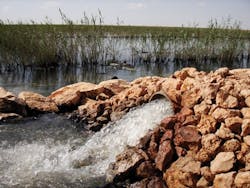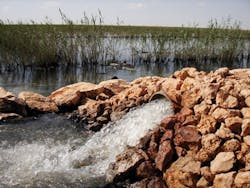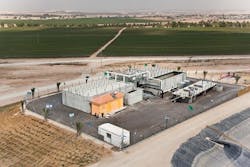Company to Showcase Mechanically Enhanced "Biodrying" Process
Siemens Water Technologies’ IPS Composing System features a Mechanically Enhanced Biodrying (MEB) system that incorporates physical processes such as forced aeration and turning of the materials to expedite moisture evaporation. Biodrying is a biological process in which organic materials produce self-generated heat that evaporates water and thereby reduces the overall weight and volume of the feedstock.
Biodrying is on the spectrum between drying and composting. It is a biological process in which organic materials produce self-generated heat that evaporates water and thereby reduces the overall weight and volume of the feedstock. Mechanically Enhanced Biodrying (MEB) incorporates physical processes such as forced aeration and turning of the materials to expedite moisture evaporation.
Siemens Water Technologies’ MEB process applies the mechanical advantages of its existing IPS composting system to the biodrying principles and develops an engineered protocol to achieve the desired results. The IPS system dries materials for fertilizer or fuel and expends minimal energy, compared to conventional drying methods.
The company’s automated, agitated bin technology can achieve 65 percent solids concentration (35 percent moisture) in biosolids by using only the finished dried product as the amendment. The IPS composting system consistently dries to 65 percent solids with an in-feed mixture of at least 40 percent solids, comprised of dewatered cake (of at least 20 percent solids) and recycled dried product discharged from the IPS system (of at least 60 percent).
Success of the process relies on the energy produced by biodegradation of volatile solids to warm the in-feed mixture, evaporate moisture, and dry it without a supplemental energy source or carbon-rich amendment. Overall, the solids concentration increases an average of approximately one percent per day and as much as two percent per day in the agitated bin system when minimum in-feed conditions are met.
While many principles of composting and biodrying are similar, there are significant differences with respect to wastewater sludge or biosolids. Biosolids composting requires a relatively high carbon-to-nitrogen ratio, high porosity, moisture maintenance, and a long process retention time to produce a marketable end-product. Shredded wood waste or other cellulose bulking agents are used, moisture may be added during the composting stage, and a curing phase follows active composting.
In biodrying, the goals usually are to stabilize, decrease both volume and moisture content, and retain the calorific value of the feedstock for end-use as a fertilizer or a fuel. Therefore, woody amendments and moisture are not added during the biodrying phase, which is ideal if wood waste and carbon-rich amendments are in short supply. The retention time is also shorter since no curing is required.
The end-product that results from the IPS biodrying process can be used for fuel or fertilizer and is generated using less energy than traditional drying technologies.
Creating a biosolids fuel product with an energy-conservative process makes MEB an ideal companion for conversion technologies. Siemens is also researching the applicability of using the MEB process to generate feedstock for gasification.
WW
More WaterWorld Current Issue Articles
More WaterWorld Archives Issue Articles


